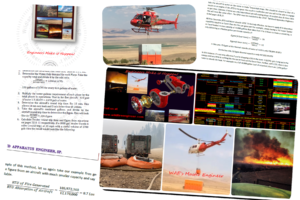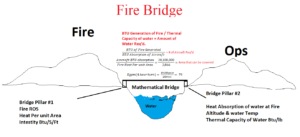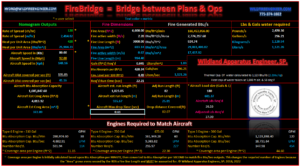A scheduled Zoom session took place on December 30th 2021. Synopsis here: Fire Bridge Session
A New Beta version (with Metrics) FireBridge Calculation spreadsheet is available for evaluation (15-days) available here: https:/www.wildfireengineer.com/FireBridge/FireBridgeCalc_4B2.zip
This works on 32 & 64 Bit windows PC’s & Laptops (even nextbook win8 tablets) and should run on older winXP machines as well. This is a Zipped executable file. There is Nothing Crippled in this version. It will allow you to run calculations that is normally based upon Fire Behavior Nomograms regarding the ROS and HPA. Other aspects are computed automatically. If you need longer than 15 days Email us with the computer code (it generates) and and we’ll adjust the evaluation time for you. Requesting feed back, suggestions etc. (Not yet for Sale).
For an understanding of the Fire Bridge concept please check out the FireBridge Link on this website and download the “Fire Nomogram use with the WAE Q-Ref”! (link below image)/ The Document below is essential in order to understand the calculations & purpose of the concept. As a rule, the FireBridge concept takes existing final data from Fire Behavior Nomograms and simply uses this information to state how much water is required based upon that data.

Updated Fire Nomogram document: Page 6, 12 & 13.
Fire Nomogram Use with Wildland Engineers QRef4
Also The Fire Bridge page on this site has a very lengthy explanation with a video of what the fire bridge in action would look like here in the states if used and properly calculated out. Further this was used in Nevada on the Martin Fire. Page Found here: https://www.wildfireengineer.com/?p=1531
A video of what Fire Bridge would actually look like . 9 CL215 scoopers dropping water on the Port de Bouc Fire in 2017 found here: https://youtu.be/Jodn7FPBLdI
All you need to do your job as an actual Apparatus Engineer, is to have a really really good FBAN and know 3 things. HPA, Btu/s/Ft, and the ROS! Then you can go to work. Aircraft would also fit the definition of an Apparatus.
Topic: Wildland Apparatus Engineer – Fire Bridge
Time: Dec 30, 2021 07:00 PM Pacific Time (US and Canada)
The FireBridge zoom session was recorded and is in 5 sessions below. Another link to the sessions will be placed in the video page.
[This was my first time using a zoom platform, so the screen share feature to be able to see all of the participants at the same time throughout the video is not always active during the entirety of the session. My apologies]

FireBridge Calculator Screen-shot

10 minutes (Part 1) Rick Gobel provides his take on the usefulness on the fire bridge concept and talks about what country is already putting the concept into use. He also talks about FireBridge in the campaign fire scene.
17 minutes (Part 1) into the video is the explanation of what makes up the pillars to the FireBridge for those that want to fast forward.
20:04 (Part 1) Dockery provides an explanation as to why there is a misunderstanding about the concept and how to possibly remove any possible resistance. Versus the standard “I have a fire so im going to drop mud to drop mud versus figuring out what I need because I don’t have time, yet you need to so you can drop the right amount of agent in the right area” and he speaks expressly of pre planning.
Continues to (Part 2). Dockery speaks that using pre planning enhances the effectiveness of the standard fire response and is actually NOT changing the response but with the pre planning, you can ADD to that response based upon the calculated BTU/ton etc. to provide the maximum cooling effect.
After Dockery, Molly provides comments that allot of the Technical folks may not always articulate the technical aspects to the operations folks. She also speaks of various tools being used and talks of folks that currently do the calculations now. (while this is correct and true, what is not being done today though is we are not teaching folks about the other side of the calculations which is what is your waters capability and ability?)
8 minutes (approx) (Part 2) Jersey describes his decision process he used based upon the FireBridge concept and then gives an account of how he actually used the concept and the process and folks he talked with to make a successful attack.
16:30 Molly (Part 2) gives a good explanation of what a person can do to get the information needed during a fire to use the FireBridge effectively. WAE not only concurs but also suggests this as the best approach for those that have no other way to derive the intel.
20: min (Part 2) Dockery speaks of we are identifying a technical gap that was not previously identified before due to fire activity not always being this extreme, etc. and that we’re bridging the gap of the where the technical expertise is.
End of Part 2 & Start of Part 3 (approx 23:50)Jersey agrees with Dockery and provides added emphasis to what Dockery is speaking of. (adding, “is the cookie cutter response alone enough based upon the pre planning of Btu or do we need to add more and what kind”?) Thus understanding the point behind the FireBridge concept allows you to make a better tactical decision.
(Part 3) (approx 1:00) Rick Gobel gives an explanation of the Jim Sage fire and what he was doing.
Part 3 at 3:00 We talk about the folks on fires doing the calcs but based upon the output, only 50% of the calcs are being done (conceptually) and not allowing for the construction or completion of the “bridge” because the response is NOT commensurate with the calculation. Using the example of the 747 Global Super, at 19,000 gallons and having a round trip time of 240 minutes is only an effective GPM rating of 79. That equates to a maximum heat absorption capacity of only 741,460.75 Btu. Even less if using the standard load with LC95.
5:57 (Part 3) Jersey adds to this topic of return times for the type of aircraft & round trip time, his aircraft was able to bring 1.2 million Btu absorption capacity to bear on the fire per aircraft.
8:13 (Part 3) Gobel provides an example to the water management and btu absorption by comparison.
10:00 (Part 3) Descriptor of what must be calculated in order for FireBridge to work.
23:00 (Part 3) Gobel provides an explanation on how FireBridge concept allows him to use his dozer more effectively with aircraft.
3:03 minutes (Part 4) Doc talks about the aspects of what’s coming and possibly soon to be required as Engineers & gives two examples of FireBridge at work as with one not understanding the concept and its implications. Dockery also talks about the fact that folks have to become more and this is actually substantiated by the OPM PD’s as they are written even now.
5:56 minutes (Part 4) Doc provides his two examples of the FireBridge.
14:00 minutes (Part 4) Doc further talks of problems with fire leadership not instilling a need for the the extra training into its captains etc and its implications can lead to a systemic problem.
15: minutes (Part 4) another example of FireBridge
9:00 minute (Part 5) Doc provides an explanation of how to more easily grasp FireBridge if it seems daunting for some.
15:00 minute (Part 5) Explanation of the Nomogram then Doc gives statements on future session topics on different fuel types and explain how to actually use the FireBridge from start to finish and then explains the possible implications as being designated a fire fighter as opposed a Rang Technician with “Other Duties as Required” then moves into liability.
Best way to view the videos is to play this as Picture in Picture to reduce the screen size and decrease pixelation.
Participants & Quals:
Chris “Jersey” Franek, New Jersey – AFMO – IC3 – Div – Rxb2
Thomas “doc” Dockery, Reno, Nv (works in California) – Capt – IC4
Rick “Dr. Dozer” Gobel, Idaho – DZIA – HEQB – FIRB – MedL – (calif FAE)
Molly Wright, New Mexico – Ecologist – FEMO – ENGB(t) – FIRB(t)
The video links below are simply the discussion the folks listed above have actually used with success and described the outcomes when not used. This was Not a training meeting.
Each Video part is 24 minutes in length:
FireBridge video Part1 https://wildfireengineer.com/FireBridge/FireBridge_Dec302021 – 1of5.mp4
FireBridge video Part2 https://wildfireengineer.com/FireBridge/FireBridge_Dec302021 – 2of5.mp4
FireBridge video Part3 https://wildfireengineer.com/FireBridge/FireBridge_Dec302021 – 3of5.mp4
FireBridge video Part4 https://wildfireengineer.com/FireBridge/FireBridge_Dec302021 – 4of5.mp4
FireBridge video Part5 https://wildfireengineer.com/FireBridge/FireBridge_Dec302021 – 5of5.mp4

Comments